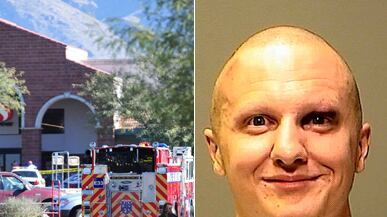Could Jared Loughner's killing spree in Arizona have been prevented? The speculation—by now a familiar postscript to blood-soaked gun rampages—began immediately after the first shot, raising some familiar issues (gun control, security), as well as some newer ones (political rhetoric, Sarah Palin.) But the incident also tapped into a fierce and ongoing argument amongst psychiatrists about how to best help people like Loughner, who experts say almost certainly suffers from schizophrenia, before they turn on themselves—or others.
At the center of the debate is the Diagnostic and Statistic Manual of Mental Disorders—a.k.a. psychiatry's bible—now being revised for the first time in a decade. Inclusion or exclusion in the tome is no picayune affair. With its evolving list of illnesses, the DSM shapes the way people talk about, recognize, and respond to mental illness, and every new edition shakes up the field by helping to determine the line between normal and not—as well as when patients should receive treatment, and what that treatment should look like. Since insurance companies often don't reimburse treatment for non-DSM disorders, inclusion is a common prerequisite for new drug development, large-scale clinical trials, and funding for ambitious research.

All of which helps explain why the first draft of the new DSM has inspired an epic fight over the inclusion of "psychosis risk syndrome" (PRS), a term for the earliest stage of schizophrenia, when the demons of full-blown insanity are just starting to bite. On one side are psychiatrists who oppose PRS because it risks misdiagnosing, treating, and stigmatizing people who may never develop schizophrenia. On the other are those who see it as the best hope for preventing true madness. While doctors have dozens of labels for flagrant insanity, there are virtually none for the stages preceding that first psychotic break—a period when a patient's sense of reality is still stronger than their hallucinations and delusions. If diagnosed and treated then, experts say, it might be possible to delay or entirely avert the disease.
In Arizona, that means "the whole ensuing nightmare could have been prevented," says Yale psychiatrist Thomas McGlashan, who was the first American to open a clinic for patients in a pre-psychotic state, "had [Loughner] been evaluated earlier for the risk syndrome." Many of his peers—including Columbia University psychiatrist Jeffrey Lieberman and William Carpenter, head of the DSM work group that's evaluating PRS—agree that an early diagnosis would, as Carpenter put it, "increase the likelihood that someone like Loughner would get treatment." The University of Maryland professor points to the case of John Hinckley Jr., Ronald Reagan's would-be assassin, whose parents later described how they tried (and failed) to find a doctor to diagnose their novel- and movie-haunted son before he tried to kill the president in 1981. Lieberman adds that the Loughner episode lends "emotional support" for including an at-risk diagnosis, and he's "sure it will have an influence" on the DSM revise.
The Loughner episode lends "emotional support" for including an at-risk diagnosis.
Pre-empting such violent attacks is, of course, crucial. (About half of all rampage murders have been attributed to schizophrenics.) But perhaps the greatest benefit of an early diagnosis is what it could do for the vast majority of schizophrenics who never turn violent or are mostly just a danger to themselves. Schizophrenia is the country's most common serious mood disorder, affecting about 1 in 100 adults who occupy about a quarter of the nation's hospital beds, according to Rachel Aviv, who is writing a book about patients in the pre-stages of psychosis. Despite its prevalence, however, the average time between the onset of illness and treatment is exceptionally long: nine years, according to a survey by the Washington DC-based National Alliance on Mental Health (NAMI) advocacy group. And with each year that passes without treatment, the chance for recovery diminishes.
McGlashan, his team at Yale, and other proponents of PRS believe that making it an officially recognized disorder could help reverse this trend. But other members of psychiatry's glitterati believes that PRS is a nightmare of its own kind. Consider the risk of false positives, they say. If doctors are wrong about PRS—which they are at least two thirds of the time, studies show—they risk meddling with the brains of perfectly healthy people, needlessly prescribing them drugs, stigmatizing them in the eyes of others, and forever altering their self-perception. In fact, even before the American Psychiatric Association (APA) released a first draft of the new manual last February, PRS was divisive. In 2009, for example, Allen Frances, lead editor of the current edition of the DSM, joined forces with his predecessor Robert Spitzer to warn of the dangers of what they called "medicalizing normality." The duo published a broadside on the website of Psychiatric Times that year and wrote a letter to the APA board, while Frances argued in a pair of Psychology Today blog posts that PRS was "clearly the prescription for a [doctor-caused] public health disaster." (Frances, who has emerged as the lead critic, did not respond to request for comment.)
The APA has tried to undermine Frances, noting that he stands to lose his royalty payments when the new DSM comes out. Nonetheless, in September, William Carpenter and his team tweaked the proposed entry for PRS, renaming it "attenuated psychotic symptoms syndrome" (APS) and, in an attempt to solve the false-positive problem, added a requirement that patients must be actively seeking a diagnosis rather than be screened by a school nurse or general practitioner. Finally, in November, McGlashan co-authored "The Case For Attenuated Psychotic Symptoms Syndrome," arguing, among other things, that at least forty percent of people diagnosed with APS-like symptoms develop mature schizophrenia within three years; the treatment is generally mild (including fish oil, for example, rather than antipsychotics) and the risk of stigma is manageable. "We explain that being at-risk isn't deterministic," says Barbara Walsh, one of McGlashan's colleague's the Yale clinic. "It's not, oh well, you or your child are going to be crazy." The question is how the Arizona incident will shape the PRS debate between now and next year, when the DSM is field tested, further revised, and finally voted on by the APA's trustees and 39,000 members. Officially, of course, it will have no impact at all. Carpenter says his team believes "the evidence is strong" that schizophrenia can be diagnosed early. But it's still split on the safety of including the syndrome, and is now awaiting the results of a trial to see if PRS is reliable in a general setting. Nothing from the world of news, he says, will affect that decision. (Oddly, despite his positive personal opinions about early diagnosis, Carpenter's official APA statement called it a "fantasy" that APS could "address the problem of violence from persons at the fringe of society.")
But if history is a guide, chatter about Loughner will leak into professional conversation. The diagnosis for homosexuality and a proposed disorder akin to post menstrual syndrome were dropped in apparent response to popular outcry, while others (like post-traumatic stress disorder) have been added to reflect the mental health needs of a changing world. "DSM work groups are not like juries. They aren't sequestered. The members read the paper in the morning and watch the news at night and inevitably that shapes their thinking," says Paul Appelbaum, a Columbia University professor and past president of the APA. And the manual, adds Jeffrey Lieberman, Appelbaum's colleague, "is as much a social and political document as a scientific one."
Even if psychosis risk syndrome does not feature in the upcoming DSM, the idea of early intervention is clearly spreading—supported by high profile conferences, special editions of the top journals, new federal funding, and the emergence of about 60 clinics aimed at helping people retain their hold on reality. About a third of those are aimed at helping people who are still in a pre-psychotic stage but getting worse—much like Jared Loughner apparently did in the years before he opened fire. "These young people are out there, they have a real problem," says Scott Woods, a psychiatry professor at Yale. "We need to learn more about how to treat them." A DSM-approved early diagnosis will help. For all its horror, Jared Loughner's performance in Arizona may help, too.
Tony Dokoupil is a staff writer and editor at Newsweek.






